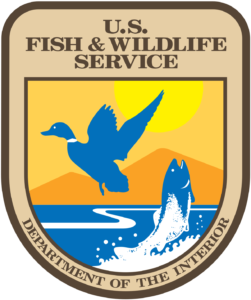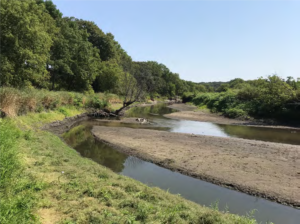Benching & Boulders: Restoring Stream Hydrology and Habitat for Wildlife and Water Quality
Tuesday, Aug. 17 | 10-10:45 a.m.
***Hey everyone! We’ve run into connection issues at Horseshoe Bend today. However, Jorgen, Brian and Darrick are out in the field recording the content now! We’ll get that footage uploaded for you to check out in the coming days. Thanks for your patience!***
Hosts: Brian Cuperus & Darrick Weissenfluh
Partners: U.S. Fish & Wildlife Service Dickinson County Conservation Board
 Join us to learn about stream restoration goals, strategies and benefits on the Little Sioux River. Hear from Brian Cuperus and Darrick Weissenfluh about a recent stream restoration and mussel habitat enhancement project completed at the Dickinson County Conservation Board’s Horseshoe Bend property that benefits both wildlife and water qual ity. Also learn more about how landowners can use conservation programs to implement similar restoration projects on their own properties.
Join us to learn about stream restoration goals, strategies and benefits on the Little Sioux River. Hear from Brian Cuperus and Darrick Weissenfluh about a recent stream restoration and mussel habitat enhancement project completed at the Dickinson County Conservation Board’s Horseshoe Bend property that benefits both wildlife and water qual ity. Also learn more about how landowners can use conservation programs to implement similar restoration projects on their own properties.
To join the live chat during the YouTube Live event, click the watch on YouTube button on the video or below. The site may ask you to “Create a Channel”. Creating a Channel only requires an email address, and is just the YouTube word for “Account”. We hope you’ll “Create a Channel” and join us in the chat to ask questions and give comments, but you can view the live event without any sign-in!
- Stream restoration
- Mussels
- Aquatic habitat
- Flood & erosion control
- Conservation programs
 Brian Cuperus is the natural resource manager for the Dickinson County Conservation Board. He works to restore and manage habitat on conservation areas to benefit people and wildlife.
Brian Cuperus is the natural resource manager for the Dickinson County Conservation Board. He works to restore and manage habitat on conservation areas to benefit people and wildlife.
![IMG 1132[1] (1)](https://practicalfarmers.org/wp-content/uploads/2021/04/IMG_11321-1-scaled-e1619559671269-300x300.jpg) Darrick Weissenfluh is a private lands biologist with the U.S. Fish and Wildlife Service’s Partners for Fish & Wildlife Program. Through voluntary agreements and by working with conservation partners, Darrick provides technical and financial assistance to restore fish and wildlife habitat throughout the Des Moines Lobe region.
Darrick Weissenfluh is a private lands biologist with the U.S. Fish and Wildlife Service’s Partners for Fish & Wildlife Program. Through voluntary agreements and by working with conservation partners, Darrick provides technical and financial assistance to restore fish and wildlife habitat throughout the Des Moines Lobe region.
Partners:
- U.S. Fish & Wildlife Service
- Dickinson County Conservation Board
This material is based upon work supported by the U.S. Department of Agriculture, under agreement number NR196114XXXXG003
Any opinions, findings, conclusions, or recommendations expressed in this publication are those of the author(s) and do not necessarily reflect the views of the U.S. Department of Agriculture.



